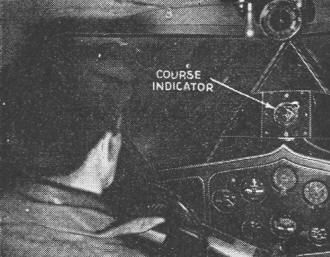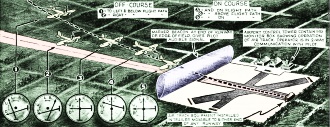"Air-Track" System of Blind Landing
|
|
The Instrument Landing System (ILS) has been around for an amazingly long time - almost as long as commercial airlines have been operating. This 1937 article in the October issue of Radio-Craft magazine reports on the current (at the time) state of the art. The Douglas DC-3 twin-engine airliner (my all-time favorite airplane) entered service in 1936 and is credited with creating widespread public acceptance of the safety and comfort of airplanes. Much of the content for this article also appeared in "The History and Development of the Washington Institute of Technology," by Joseph M. Mahzolf, Jr., published November 18, 1938. The ILS has been replaced or augmented in many locations with the Microwave Landing System (MLS) and/or the GPS-based Wide Area Augmentation System (WAAS). "Air-Track" System of Blind Landing By Charles E. Planck The familiar "curved beam" radio safe landing system has been developed by the Washington Institute of Technology to the point where it is now ready for commercial use on any airport. Figure A is an action view of the system shown in Fig. B. (Figure B is a phantom diagram prepared by staff artist T. D. Pentz.) Six important improvements have been incorporated in the Air-Track. Foremost among these are the facts that (1) the equipment has been so simplified and the design made so compact, that it is portable, making it possible to lead a pilot in to a safe landing from either end of any runway on the field; (2) the radio signals, at first liable to deviation and instability, have been made reliable, and a monitoring system installed which indicates to the operator whether accurate signals are being broadcast; (3) both the localizer and the glide path are quickly adjustable and, (4) the equipment required in the plane has been made lighter and more efficient. The principles embodied in this system were originally worked out by an Aeronautics Research Division established by the Department of Commerce at the Bureau of Standards. A number of the radio scientists who developed the system at the Bureau have been at work in a laboratory at College Park Airport near Washington developing the system from its early experimental stages to the point where it is now practical for air transport. Three years of such development and improvement work have resulted in hundreds of successful landings "under the hood" and landings in fog conditions which interrupted scheduled flying. Fig. B - Any deviation of the plane from the sloping "air track" while landing is instantly recorded on the "cross-pointer" meter on instrument board. Three experimental installations of this curved beam type of landing system have been tested by Department of Commerce pilots, airline pilots and others. These are at College Park, Newark airport, and the municipal airport at Oakland, California. In all, upwards of 1,000 safe instrument landings have been made on these installations. Elements of the Air-Track System Briefly, the Air-Track system consists of two radio beams: (1) a runway localizer which lies down the center of the runway to be used. and (2) a curved glide path which leads the plane down a loping "track" to a gentle landing on the runway. A single "cross-pointer" instrument (2 D.C. meter movements, one operating horizontally and the other vertically, mounted in one case) on the panel (see Fig. A) indicates the plane's position, the vertical needle pointing to the right or left if the plane veers from the center of the runway localizer, and the horizontal needle rising or falling if the plane gets above or below the proper glide path. At a distance of 10 or 15 miles from the airport (see Fig. B), the pilot picks up the runway localizer signal through his regular communications receiver, over which he still receives voice communication, perhaps from the operator in the airport control tower. Lining up his flight along this localizer, which can be made as wide or as narrow as comfortable flying dictates, he approaches the curved beam down which he will glide to the runway. (The receiver for this glide path is adjusted to the best "gliding angle" of that type of plane.) Having reached this point, the pilot flies his plane so that the 2 needles cross at right-angles, and this indicates that he is approaching over the exact center of the runway and coming down at the proper safe gliding angle. At the edge of the field a marker beacon gives him a signal in his earphones which tells him he is crossing the edge of the field. At this time he is approximately 20 to 30 feet above the runway, and the balance of the landing consists merely of leveling off and letting the plane settle. Hundreds of times, planes with landing speeds as high as 75 miles an hour have been brought down to a spot on the field a few yards square! James L. Kinney, Department of Commerce pilot, as far back as 1933, took off from Washington under the hood (that is, he could not see outside the plane, had only his instruments to guide him, and hence was flying "blind"), flew by instrument to Newark airport, and landed by instrument on the experimental installation of this system, on a day when scheduled air transport planes were grounded by impossible flying weather. Transmitting equipment is housed in an ordinary automobile trailer which is quickly movable to concrete platforms at either end of any runway, where the wheels fit into slots to insure proper location of the apparatus. The transmitters are plugged in to a power outlet and the control tower attendant throws a switch which puts them into operation. Usefulness of "Air-Track" at Crowded Airports Usefulness of the apparatus for control of traffic at crowded airports has been stressed by pilots who have flown the system. Airline officials have pointed out that if all landings of air transport planes were made on this system, even in fine weather, a pilot would never make an unusual landing, no matter what the weather might be. Despite the thoughtful and serious work of airline operations managers and traffic managers in "staggering" schedules to avoid simultaneous arrival of several airliners at one airport at the same time, the airports at large municipalities are already dangerously crowded at certain times. At one airport today, there are 18 transport planes arriving within the space of an hour. Increasing patronage will only aggravate this problem, and bad weather complicates it to the point of deadly hazard. It is as if the engineers of a large number of trains were instructed to choose their own track and bring their trains in to a huge station with only the admonition to "be careful and not run into other trains." The airline pilot has two-way voice communication with the airport control tower, and receives all the information available, but he does not have a definite "track" or path to follow which will keep him clear of other approaching aircraft. A correct blind landing system may have a number of duplicate "tracks", properly identified, just as are the tracks in a railroad yard, and the approaching pilot's orders will indicate the track he is to use. Eventually, these engineers believe, the "switches" may be set for the approaching pilot, and his plane may be taken over by radio when he is distant from the field, and brought in mechanically to a full instrument landing. This dream is not very nebulous, even today. Comparison of Various Blind-Landing Systems There are no "preceding types" of landing systems prior to the Air-Track. It is based definitely upon the original experiments at the Bureau of Standards, which began in 1927 and 1928. An Aeronautical Development Section of the Department of Commerce, Aeronautics Branch, conducted those experiments, and carried them up through various stages of development to the demonstrations held at Newark in 1933. As for other landing systems (Most of these systems have been described in past issues of Radio-Craft. -Editor), this is the story. In 1931 or 1932, visitors from Germany were shown the Bureau's developments and after their return to Germany the Lorenz system appeared. This is a refinement and development of one of the phases of the Bureau development. At Newark, the Bureau installation was fixed in position, giving indication in only one direction. The Lorenz system today is also fixed in one position. If it is desired to give landing guidance on more than one runway, or in more than one direction, the installation must be duplicated. This means that under certain conditions, the pilot will be coming in to land over the antenna structure and transmitter houses. These form a positive obstacle, much disliked by pilots. There is also the consideration of the added expense necessary to duplicate these transmitters and antenna arrays and structures. The Lorenz system also uses a European type of indication, with a kicking needle indicating off-course position. This is strange to American pilot practice and preference, and it requires an appreciable time for interpretation. There is no time available for interpretation in the job of blind landing. The Lorenz system holds to the fundamental principles of the Bureau system, i.e. the "curved beam", localizer and marker beacons. It gives the pilot an indication of his position throughout the approach and landing. However, it is not all contained on the airport, and it has not been developed as far as Air-Track. The success of the Bureau demonstrations at Newark prompted the duplication of the system at Oakland airport in California. Here, United Airlines, later joined by TWA and American Airlines, and still later by Bendix, have continued their development. They have not released much on their development, but we understand that it is still fixed in position, although it retains the fundamental principles of the Bureau system. The 4 major Airlines, AA, TWA, UAL and EAL, meeting with Bureau of Commerce and Federal Communications Commission representatives recently set forth: recommended specifications for instrument landing to be adopted on a national scale. It is interesting to note that Air-Track exceeds the operating requirements of these specifications, meets all the requirements described as "practicable," and most of those which are called "projected developments." For example, the specifications suggest that glide path and localizer indications should be separate. The Bureau started with separate transmitters and we regard them as essential to safety and proper operation. We believe this instrument landing situation has implications which make it the biggest story in radio or aviation at this time. Entirely aside from the safety angle, its economic angle is sure to have a tremendous effect on the history of air transportation. Credits When a curtailment of funds necessitated a discontinuance of Department of Commerce activities on radio aids to flying in 1933, scientists who had been employed at the Bureau were set up in a new laboratory at College Park where they continued their research and experiments. Among these men were Gomer L. Davies, Dr. Frank G. Kear, Gerald H. Wintermute, and the late William H. Orton, who are largely responsible for the improvement of the Air-Track and its adaptation to commercial needs. The first job of instrument landing is to save lives. Its second job is to make possible the completion of every trip interrupted or cancelled because the terminal airport is "closed in", and thus to guarantee flying on an announced schedule. The story of its contributions will be the first chapter in an entirely new epoch of human flight. Airlines of the country took a big step toward 100% in safety and regularity of scheduled operation when they recently agreed upon specifications for an acceptable instrument landing system. As a result, it appears that a workable system will have been tested and accepted before the arrival of bad flying weather this winter.
Posted October 30, 2023 |
|


